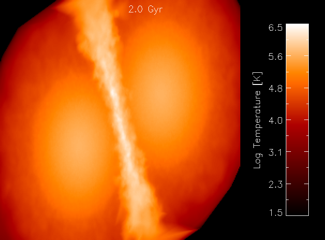kelly holley-bockelmann







With Miroslav Micic and Steinn Sigurdsson, we used this 10 million particle simulation of a 10 Mpc3-sized volume of the universe to study the merger rates of supermassive black holes from redshift 20 to today.

I am interested in galaxy dynamics, N-body simulations, supermassive black holes, and gravitational waves. Though this page is under construction, you’re welcome to take a peek at the images from some of our recent projects. Feel free to email me if you want to know more.
When black holes merge, they emit huge amounts of gravitational radiation -- and if the merger is not symmetric (say the spins are mis-aligned, or the masses are different), these gravitational waves are emitted in a preferred direction. This sends the new black hole careening off in with a recoil velocity that can be up to 9 million miles per hour! Such rapidly moving black holes will easily escape low mass systems like globular clusters. With Kayhan Gultekin, Nico Yunes, and Deirdre Shoemaker, we’re studying how well globular clusters can retain Intermediate Mass Black Holes against an onslaught of black hole mergers.





